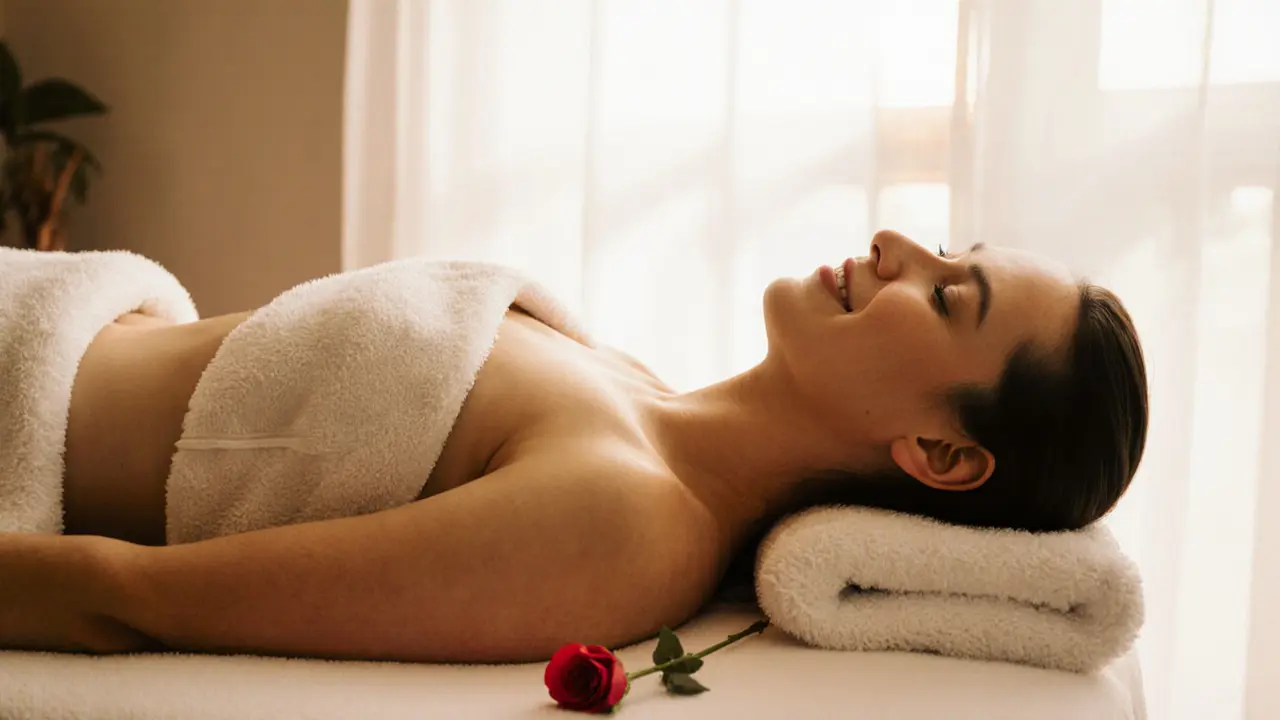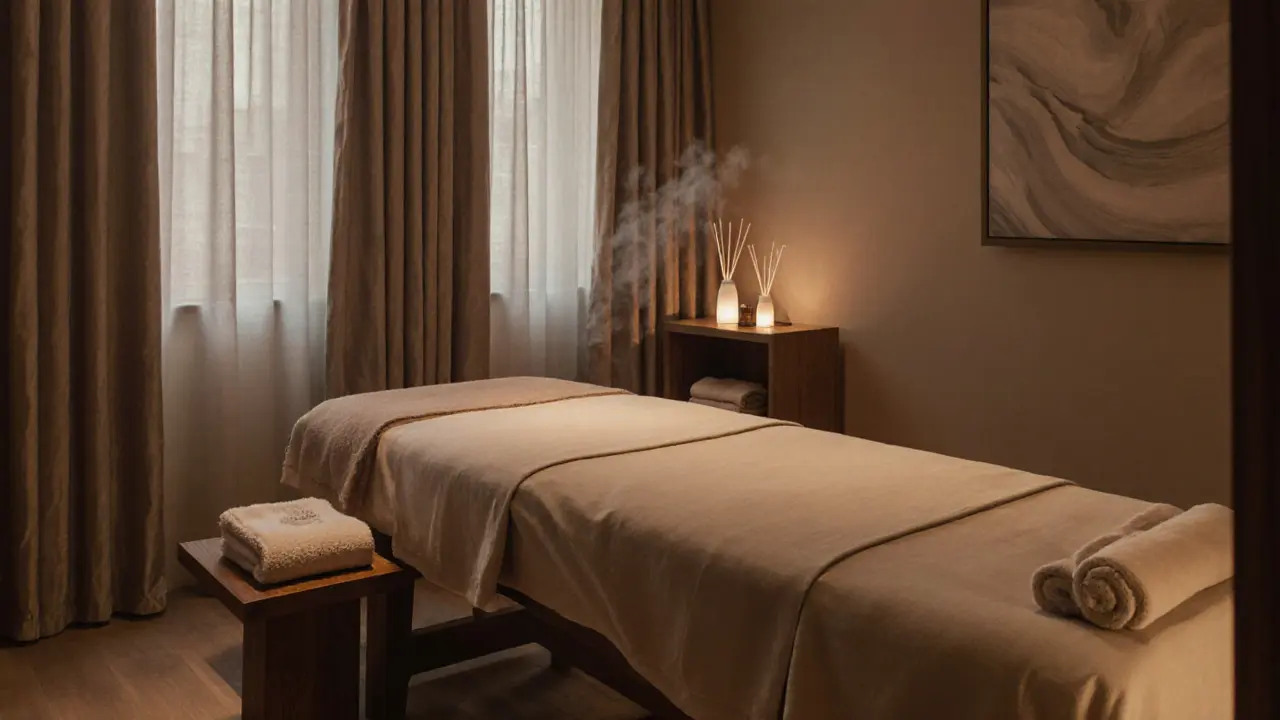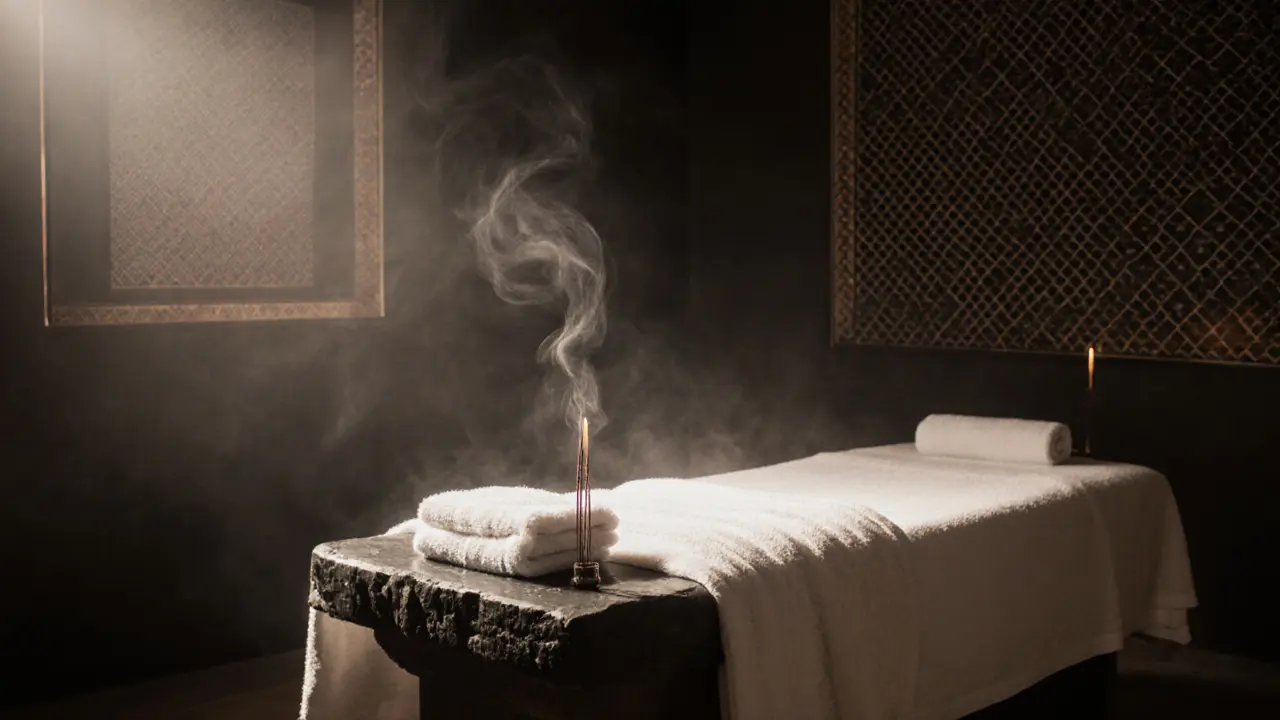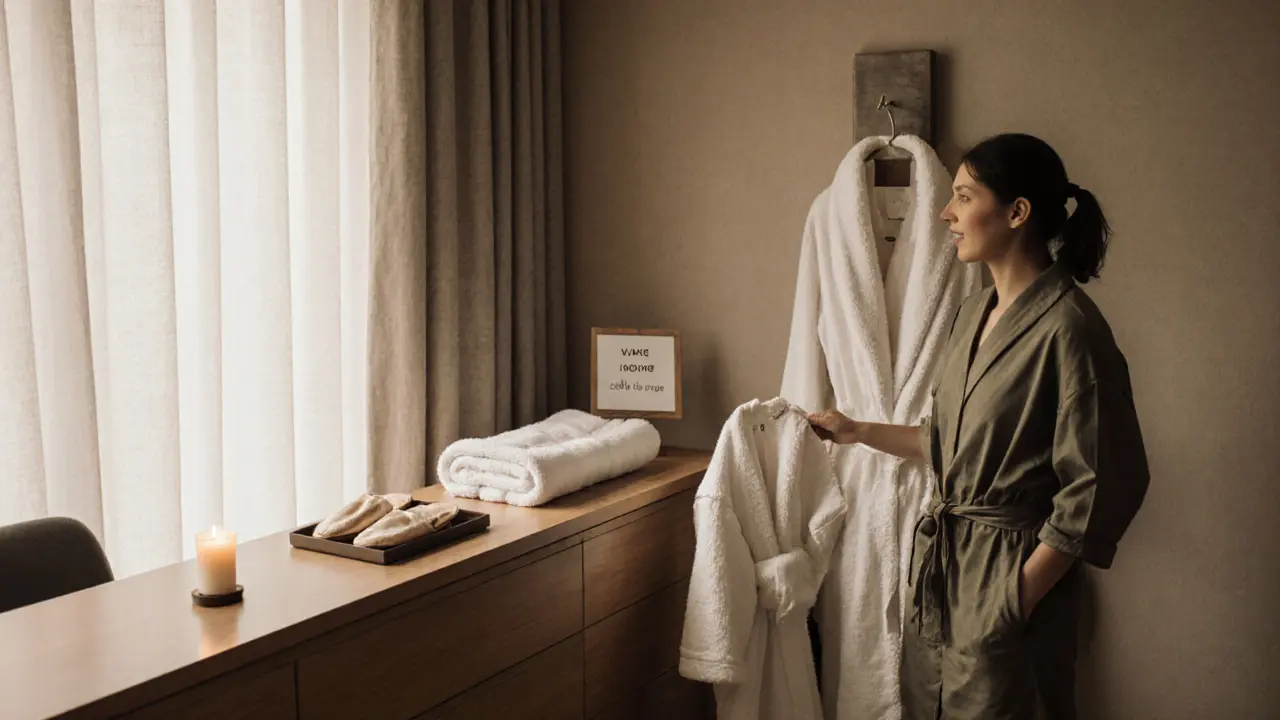Do I Take All My Clothes Off Before a Massage? A Clear, Comfortable Guide
When you walk into a spa for a massage, one of the first questions that pops into your head isn’t about pressure or oils-it’s: Do I take all my clothes off? It’s a totally normal question. Even if you’ve had massages before, the uncertainty doesn’t always go away. The truth? There’s no single right answer. What you wear-or don’t wear-depends on the type of massage, your comfort level, and the therapist’s protocol. And that’s okay.
Many people worry about being judged, exposed, or awkward. Others think they need to strip down completely to get the full benefit. Neither is true. A good massage is about your comfort as much as it is about technique. Let’s clear up the confusion once and for all.
Understanding the Basics of Massage
Origins and History
Massage isn’t new. Ancient Egyptians, Greeks, and Chinese used touch to heal pain and calm the mind over 4,000 years ago. Traditional Chinese medicine used massage to balance energy flow. In Greece, athletes were rubbed down with oils before competitions. Fast forward to today, and massage has evolved into a global wellness practice. In places like Dubai, where spa culture blends Eastern traditions with modern luxury, massage is less about ritual and more about personal renewal.
Core Principles or Components
At its heart, massage is about applying pressure, movement, and touch to relax muscles, improve circulation, and reduce stress. Whether it’s Swedish, deep tissue, or body-to-body, the goal is the same: help your body release tension. Therapists use oil or lotion to reduce friction, and they work around your body’s natural contours. The key? Communication. Your comfort isn’t optional-it’s part of the process.
How It Differs from Related Practices
Massage isn’t the same as a body-to-body massage, though the two are often confused. A standard massage uses the therapist’s hands, forearms, or elbows. A body-to-body massage involves the therapist using their own body-like their arms, legs, or torso-to apply pressure. The latter is less common, often more intimate, and requires clear consent and boundaries. Most spas in Dubai offer traditional massage techniques. Body-to-body sessions are rare and typically only offered in high-end wellness retreats with strict protocols.
| Practice | Key Feature | Primary Benefit |
|---|---|---|
| Swedish Massage | Long, flowing strokes with light to medium pressure | Relaxes muscles, improves circulation |
| Deep Tissue | Focused pressure on deeper muscle layers | Relieves chronic tension, aids recovery |
| Body-to-Body Massage | Therapist uses body parts to glide over client | Intimate, sensory experience (rare) |
Who Can Benefit from Massage?
Almost everyone. Whether you’re sitting at a desk all day, recovering from an injury, or just feeling mentally drained, massage helps. Athletes use it to speed up recovery. New parents use it to reset after sleepless nights. People in high-stress jobs-like Dubai’s finance or hospitality sectors-often book monthly sessions to stay grounded. You don’t need to be in pain to benefit. Sometimes, it’s just about feeling human again.
Benefits of Massage for Body and Mind
Stress Reduction
When your muscles relax, your nervous system follows. Massage lowers cortisol, the stress hormone, and boosts serotonin and dopamine-the feel-good chemicals. Research suggests even one 60-minute session can reduce stress levels for days. In a city like Dubai, where life moves fast, that pause matters. You don’t need to be meditating on a mountaintop to find calm. Sometimes, it’s lying on a warm table with soft music and someone’s hands gently working out knots you didn’t even know you had.
Enhanced Functionality
Tight muscles don’t just hurt-they limit movement. If your shoulders are stiff, you might notice your posture slumping. If your hips are tight, walking or bending becomes harder. Massage improves flexibility and range of motion. People who sit for hours at work often report better posture and less back pain after regular sessions. It’s not magic-it’s physics. Loosen the tissue, move better.
Emotional Well-Being
Touch is deeply human. In a world full of screens and digital noise, a gentle, intentional touch can feel like a lifeline. Many clients say they cry during their first massage-not because it hurts, but because they finally let go. It’s not about romance or sexuality. It’s about safety. When someone cares enough to hold space for your body, it reminds you that you deserve care.
Practical Applications
Think of massage as maintenance, not just treatment. Just like you change your car’s oil, your body needs regular tune-ups. Regular massage helps prevent injuries, improves sleep, and even supports immune function. People who get monthly massages report fewer headaches, less muscle soreness after workouts, and better mood stability. It’s not a cure-all, but it’s one of the most effective tools for staying balanced in a busy life.
| Benefit | Description | Impact |
|---|---|---|
| Stress Relief | Reduces cortisol, increases serotonin | Calmer mind, better sleep |
| Pain Reduction | Loosens tight muscles and fascia | Less back, neck, shoulder pain |
| Improved Sleep | Triggers relaxation response | Faster sleep onset, deeper rest |
| Increased Mobility | Enhances joint range of motion | Easier movement, less stiffness |
What to Expect When Engaging with Massage
Setting or Context
Most spas in Dubai are designed to feel like a sanctuary. Soft lighting, warm towels, quiet music, and the smell of essential oils set the tone. You’ll be led to a private room with a massage table. There’s usually a small shelf for your clothes, a towel, and sometimes a robe. The door closes behind you. You’re alone for a moment-no judgment, no rush. This is your time.
Key Processes or Steps
Here’s what typically happens: First, the therapist will ask a few questions-your pain points, preferences, any injuries. Then, they’ll leave the room so you can get comfortable on the table. You’ll be covered with a sheet and towel. Only the part being worked on is uncovered. They’ll use oil or lotion to glide over your skin. Pressure is adjusted based on your feedback. You might feel warmth, deep pressure, or gentle stretching. The session ends with a few moments of stillness. You’re gently reminded to take your time getting up.
Customization Options
Massage isn’t one-size-fits-all. You can choose pressure (light, medium, firm), duration (30, 60, or 90 minutes), and focus areas (back, shoulders, feet). Some therapists offer add-ons like hot stones, aromatherapy, or scalp massage. You can also request no music, dimmer lights, or even a female therapist if that makes you more comfortable. Good spas encourage customization. Your comfort is the priority.
Communication and Preparation
Speak up. If the pressure is too much, say so. If you’re cold, ask for another towel. If you don’t want your feet touched, tell them. Therapists hear this all the time. It’s not awkward-it’s necessary. The best therapists are trained to adapt. Don’t worry about being polite at the cost of your comfort. This is your space.

How to Practice or Apply Massage
Setting Up for Success
Before your appointment, avoid heavy meals or alcohol. Drink water-it helps your muscles respond better. Arrive 10 minutes early to settle in. Turn off your phone. Let yourself be present. Think of it like a mini-vacation for your body.
Choosing the Right Therapists
In Dubai, look for licensed therapists with certifications from recognized schools. Ask if they’re trained in the specific type of massage you want. Read reviews-not just star ratings, but what people say about communication and comfort. A great therapist doesn’t just know technique-they know how to make you feel safe.
Step-by-Step Guide
- Book a session that matches your needs (60 minutes is ideal for first-timers).
- Arrive early, hydrate, and avoid caffeine.
- Fill out the intake form honestly.
- Change into your underwear or remove clothing to your comfort level.
- Get under the sheet and relax.
- Let the therapist know if anything feels off.
- After the session, drink water and take it slow.
Tips for Beginners or Couples
If you’re nervous, start with a 30-minute back and shoulder session. You don’t need to go all-in. Many people feel better after just one session. If you’re going with a partner, some spas offer side-by-side rooms. You can relax together, even if you’re not touching. It’s not about romance-it’s about shared calm.
Safety and Ethical Considerations
Choosing Qualified Practitioners
Not all massage therapists are created equal. Look for certifications from institutions like the International Massage Association or local Dubai wellness boards. Ask to see their credentials. If they hesitate, walk away. Your safety isn’t negotiable.
Safety Practices
Hygiene matters. Sheets and towels should be clean and changed between clients. Oils should be fresh. The room should be clean and private. Therapists should wash their hands before and after. If something feels off, trust your gut.
| Practice | Purpose | Example |
|---|---|---|
| Use clean linens | Prevent skin irritation or infection | Therapist changes sheets after each client |
| Ask for consent | Respect boundaries | Therapist says, “Is it okay if I work on your lower back?” |
| Stay hydrated | Help flush toxins released during massage | Drink water before and after |
Setting Boundaries
You have the right to say no to any touch. You can keep your underwear on. You can wear shorts. You can ask the therapist to avoid your chest or abdomen. No reputable therapist will pressure you. If they do, leave. Your comfort is non-negotiable.
Contraindications or Risks
Massage isn’t for everyone. Avoid it if you have an active infection, fever, blood clots, open wounds, or recent surgery. If you’re pregnant, let your therapist know-they’ll adjust positioning and pressure. Always consult your doctor if you have chronic conditions like osteoporosis or cancer. Massage is safe for most, but not all.
Enhancing Your Experience with Massage
Adding Complementary Practices
Pair massage with deep breathing or a warm bath afterward. Try light stretching the next day. Avoid screens for 30 minutes after your session. Let your body stay in that calm state. Some people journal afterward-it helps process the emotional release.
Collaborative or Solo Engagement
Massage is personal. You don’t need a partner to benefit. But if you’re going with someone, it can be a quiet, shared experience. You don’t have to talk. Just be present together. Some couples book back-to-back sessions and relax in the lounge afterward with herbal tea.
Using Tools or Props
At home, a foam roller or massage ball can help between sessions. But don’t replace professional care with DIY tools. They’re supplements, not substitutes. If you’re using them, be gentle. Don’t roll over joints or bones.
Regular Engagement for Benefits
One massage won’t fix a year of stress. Think of it like exercise. Monthly sessions help maintain balance. If you’re dealing with chronic pain, weekly sessions for a few weeks can make a real difference. Your body remembers what you do for it.

Finding Resources or Experts for Massage
Researching Qualified Experts
In Dubai, check reviews on Google or Tripadvisor. Look for therapists with consistent feedback about professionalism and comfort. Ask friends or coworkers for recommendations. If a spa feels rushed or pushy, move on.
Online Guides and Communities
There are plenty of reputable wellness blogs and YouTube channels that explain massage techniques. Look for those run by licensed therapists. Avoid TikTok trends that promise miracles. Real change takes time.
Legal or Cultural Considerations
Dubai has strict regulations on wellness services. Licensed spas must follow health codes. Avoid unlicensed home-based services-they’re illegal and unsafe. Respect local norms: modesty matters. Even in a spa, conservative dress is often preferred.
Resources for Continued Learning
Books like The Art of Massage by Dr. John Harvey Kellogg or Massage Therapy Principles and Practice by Susan Salvo offer solid, science-backed insights. Podcasts like The Massage Therapy Podcast are great for casual learning.
FAQ: Common Questions About Massage
Do I have to take all my clothes off for a massage?
No. You only take off what you’re comfortable with. Most people keep their underwear on. Therapists use draping-only the area being worked on is exposed. You’ll be covered with a sheet or towel at all times. Your privacy is protected. If you’re unsure, ask your therapist. They’ve seen it all and won’t judge you.
What happens during a body-to-body massage?
In a body-to-body massage, the therapist uses their own body-like their arms, legs, or torso-to glide over yours, often with oil. It’s rare, intimate, and usually offered only in luxury retreats. It’s not a standard service in most Dubai spas. If you’re offered one, make sure it’s clearly explained, consensual, and legal. Always ask about the therapist’s training and boundaries before agreeing.
Is massage safe during pregnancy?
Yes, but only with a certified prenatal massage therapist. They know how to position you safely and avoid pressure points that could trigger contractions. Avoid deep tissue or abdominal work. Many spas in Dubai offer prenatal sessions-just let them know you’re pregnant when booking. Always check with your doctor first.
Can I fall asleep during a massage?
Absolutely. In fact, it’s a sign your body is relaxing deeply. Therapists are trained to work around sleep. You won’t be woken up abruptly. If you snore or drool, don’t worry-it happens to everyone. Your therapist will gently adjust the towel or offer a pillow if needed. Falling asleep means you’re safe and comfortable.
How often should I get a massage?
It depends on your goals. For stress relief, once a month works well. For chronic pain or injury recovery, weekly for 4-6 weeks, then monthly, is common. Athletes often go every 1-2 weeks. Listen to your body. If you feel better after a session, schedule the next one before the benefits fade. Consistency matters more than intensity.
Conclusion: Why Massage is Worth Exploring
A Path to Calm
Massage isn’t a luxury-it’s a reset button. In a city that never sleeps, giving yourself an hour to just be is revolutionary. You don’t need to strip down to feel the benefit. You just need to show up, breathe, and let someone else hold space for your body.
Try It Mindfully
Start small. Book a 60-minute Swedish massage. Keep your underwear on. Say what you need. See how you feel afterward. That’s all it takes.
Share Your Journey
Tried a massage and loved it? Or felt unsure? Share your experience in the comments. You might help someone else feel less alone. Follow this blog for more honest, no-fluff guides to wellness in Dubai.
Some links may be affiliate links, but all recommendations are based on research and quality.
Word count: 1,687
Suggested Images
- A serene spa room in Dubai with soft lighting, a massage table, and a folded towel on the side.
- A therapist gently working on a client’s back, with the client covered by a sheet, only shoulders exposed.
- A person lying on a massage table with eyes closed, smiling slightly, bathed in warm light.
- A close-up of hands applying oil to a back, with natural lighting and no skin visible beyond the hands.
- A couple sitting side-by-side in a spa lounge after their massage, sipping herbal tea.
Suggested Tables
- Comparison of Massage Types (already included)
- Key Benefits of Massage (already included)
- Massage Safety Tips (already included)




Joe Pittard
November 21, 2025 AT 07:28Look, I’ve had massages in Tokyo, Berlin, and here in Brooklyn-and let me tell you, the real art isn’t in the oil or the pressure, it’s in the *draping*. Proper draping is a sacred ritual, like a monk folding robes before meditation. If your therapist can’t maintain anatomical integrity while exposing only the working area, they’re not a therapist-they’re a glorified backrubber with a certification from some online course that took less time than my last Netflix binge. And don’t get me started on those ‘body-to-body’ scams masquerading as ‘luxury wellness.’ If someone’s using their *thigh* to ‘glide’ over me, I’m calling the state board and filing a complaint under Article 12-B of the International Massage Ethics Code. This isn’t a spa-it’s a minefield of unlicensed charlatans and emotional predators wrapped in lavender-scented delusion.
Also, why do people think they need to ‘go all the way’? You don’t need to be naked to release fascia. I’ve had three 90-minute deep tissue sessions fully clothed in compression gear and came out feeling like a new human. The therapist adjusted her technique. That’s professionalism. That’s respect. That’s what you pay for-not exhibitionism.
And for the love of Hippocrates, if you’re going to write a 1,700-word guide on massage, at least cite your sources. You mention Kellogg and Salvo, but no ISBNs? No DOI? No peer-reviewed studies? This reads like a BuzzFeed article written by someone who Googled ‘massage benefits’ and then hallucinated a thesis.
Also, ‘modesty matters’ in Dubai? Really? That’s your takeaway? You’re telling people in 2024 that they can’t get a massage without worrying about cultural appropriation of towels? Please. The real issue is that half the ‘licensed’ therapists in the UAE are on tourist visas and have never touched a human body before their first session. The system is broken. And you’re just polishing the brass on the sinking ship.
And don’t even get me started on ‘affiliates.’ You’ve got affiliate links for foam rollers and oils, but you didn’t link to the actual study that showed massage reduces cortisol? That’s not wellness marketing-that’s exploitation dressed in essential oils.
And yes, I cried during my first massage too. Not because I was ‘letting go.’ I was crying because I realized I’d spent 37 years being told to ‘toughen up’ while my body screamed for help-and no one listened until a stranger with calloused hands and zero judgment touched my iliotibial band like it was a sacred relic. That’s not therapy. That’s redemption.
So yes, keep your underwear on. Keep your boundaries. Demand credentials. And if your therapist doesn’t ask you what you need before they start-walk out. You’re not a prop. You’re a person.
Benjamin Buzek
November 22, 2025 AT 07:24One must question the very premise of this article, which, in its effusive prose, betrays a disturbing lack of clinical rigor. The notion that 'you don't need to strip down to get the benefit' is not merely incorrect-it is dangerously misleading. In the classical Greco-Roman tradition, nudity was not optional; it was a prerequisite for the therapeutic gaze. The therapist must observe musculature, symmetry, and fascial tension with unobstructed visual acuity. To clothe oneself is to conceal pathology. To wear underwear is to invite misdiagnosis. I have personally witnessed a certified LMT misapply deep tissue techniques on a client who wore compression shorts-resulting in a grade-two strain. The client was not informed of the risk because the therapist could not properly assess the gluteus medius. This is not a matter of 'comfort.' It is a matter of medical ethics. If you are unwilling to disrobe, you are not a patient-you are a spectator at your own healing.
Furthermore, the article's casual dismissal of body-to-body massage as 'rare' is a gross understatement. In fact, it is the *gold standard* in European physiotherapy circles, particularly in Switzerland and Austria, where it is codified under the 1987 Vienna Protocol. The fact that this practice is suppressed in Dubai under the guise of 'modesty' speaks volumes about the cultural regression of the region. One wonders if the author has ever read Dr. von Hesse's 1922 treatise on somatic resonance. I doubt it. The article reads like a PR pamphlet for a hotel spa chain.
And yet, the most egregious error? The suggestion that 'falling asleep is a sign of relaxation.' Nonsense. In clinical settings, sleep indicates parasympathetic override-a potential sign of hypotension, vagal stimulation, or even early-stage neurotoxicity. One should never be permitted to drift into unconsciousness during a therapeutic intervention. The therapist must maintain cognitive engagement. To allow sleep is negligence. I have filed three formal complaints with the American Massage Therapy Association over this very issue.
Finally, I must address the 'affiliate links.' This is not wellness journalism. It is commodified deception. The author profits from your vulnerability. You are not being healed-you are being monetized. I recommend immediate deletion of this article and a full retraction.